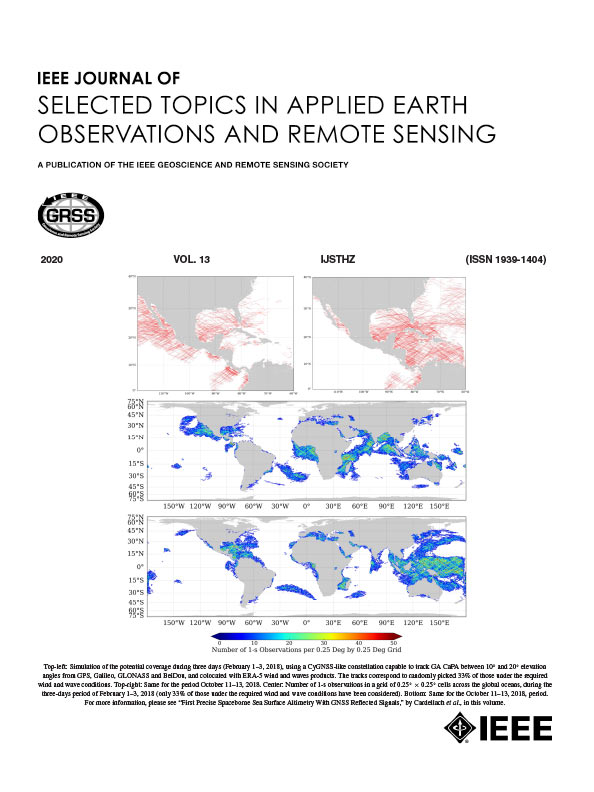Planetary Boundary Layer Height Estimation: Methodology and Case Study Using NAST-I FIREX-AQ Field Campaign Data
IF 4.7
2区 地球科学
Q1 ENGINEERING, ELECTRICAL & ELECTRONIC
IEEE Journal of Selected Topics in Applied Earth Observations and Remote Sensing
Pub Date : 2025-04-11
DOI:10.1109/JSTARS.2025.3556546
引用次数: 0
Abstract
The ratio of potential temperature (Tp) and dewpoint temperature (Td), which is derived from retrievals of infrared hyperspectral measurements, is adopted as a new parameter for better estimating planetary boundary layer height (PBLH). A case study, conducted with National Airborne Sounder Testbed-Interferometer (NAST-I) measurements obtained during the Fire Influence on Regional to Global Environments and Air Quality field campaign, is presented herein. We use NAST-I geophysical parameter retrievals from the Single Field-of-view Sounder Atmospheric Product algorithm, which ensures higher vertical resolution of temperature and moisture profiles as well as accurate surface temperature and emissivity, to estimate PBLH with a higher horizontal spatial resolution of 2.6 km. As a result of using the ratio of potential and dewpoint temperatures, instead of individual thermodynamic retrievals, a more robust parameter for estimating PBLH is obtained. A quality control process is developed to filter out abnormal outliers. Additionally, those outliers are modified using statistics from nominal distributions of the Tp/Td ratio and PBLH. A high consistency between NAST-I thermodynamically-retrieved PBLH and that from the European Centre for Medium-Range Weather Forecasts Reanalysis-5, which uses both dynamic and thermodynamic information, successfully supports the validity and significance of our approach.行星边界层高度估计:使用NAST-I FIREX-AQ野外战役数据的方法和案例研究
利用红外高光谱测量数据反演的势温(Tp)与露点温度(Td)之比,作为估算行星边界层高度的新参数。本文介绍了在火灾对区域到全球环境和空气质量的影响现场活动中,使用国家机载测深试验台干涉仪(NAST-I)测量结果进行的案例研究。我们利用单视场探测大气产品(Single Field-of-view Sounder Atmospheric Product)算法反演的NAST-I地球物理参数,以2.6 km的水平空间分辨率估算PBLH,该算法确保了更高的垂直分辨率的温度和湿度剖面以及精确的地表温度和发射率。由于使用了势温度和露点温度的比值,而不是单独的热力学反演,得到了一个更鲁棒的PBLH估计参数。开发了一种质量控制流程来过滤异常异常值。此外,使用Tp/Td比率和PBLH名义分布的统计数据对这些异常值进行了修正。nast - 1热力反演的PBLH与欧洲中期天气预报再分析中心(European Centre for Medium-Range Weather forecasting Reanalysis-5)的数据高度一致,成功地支持了我们方法的有效性和重要性。
本文章由计算机程序翻译,如有差异,请以英文原文为准。
求助全文
约1分钟内获得全文
求助全文
来源期刊
CiteScore
9.30
自引率
10.90%
发文量
563
审稿时长
4.7 months
期刊介绍:
The IEEE Journal of Selected Topics in Applied Earth Observations and Remote Sensing addresses the growing field of applications in Earth observations and remote sensing, and also provides a venue for the rapidly expanding special issues that are being sponsored by the IEEE Geosciences and Remote Sensing Society. The journal draws upon the experience of the highly successful “IEEE Transactions on Geoscience and Remote Sensing” and provide a complementary medium for the wide range of topics in applied earth observations. The ‘Applications’ areas encompasses the societal benefit areas of the Global Earth Observations Systems of Systems (GEOSS) program. Through deliberations over two years, ministers from 50 countries agreed to identify nine areas where Earth observation could positively impact the quality of life and health of their respective countries. Some of these are areas not traditionally addressed in the IEEE context. These include biodiversity, health and climate. Yet it is the skill sets of IEEE members, in areas such as observations, communications, computers, signal processing, standards and ocean engineering, that form the technical underpinnings of GEOSS. Thus, the Journal attracts a broad range of interests that serves both present members in new ways and expands the IEEE visibility into new areas.

 求助内容:
求助内容: 应助结果提醒方式:
应助结果提醒方式:


